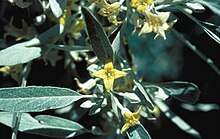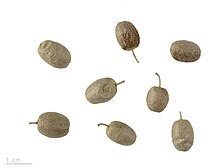Elaeagnus angustifolia
| Elaeagnus angustifolia | |
|---|---|

| |
| Scientific classification | |
| Kingdom: | Plantae |
| Clade: | Tracheophytes |
| Clade: | Angiosperms |
| Clade: | Eudicots |
| Clade: | Rosids |
| Order: | Rosales |
| Family: | Elaeagnaceae |
| Genus: | Elaeagnus |
| Species: | E. angustifolia
|
| Binomial name | |
| Elaeagnus angustifolia | |

Elaeagnus angustifolia, commonly called Russian olive,[1] silver berry,[2] oleaster,[2] or wild olive,[2] is a species of Elaeagnus, native to western and central Asia, Iran, from southern Russia and Kazakhstan to Turkey, and parts of Pakistan. It is now also widely established in North America as an introduced species.
Name
Its common name comes from its similarity in appearance to the olive (Olea europaea), in a different botanical family, the Oleaceae.
Description
Elaeagnus angustifolia is a usually thorny shrub or small tree growing to 5–7 m (16–23 ft) in height. Its stems, buds, and leaves have a dense covering of silvery to rusty scales. The leaves are alternate, lanceolate, 4–9 cm (1+1⁄2–3+1⁄2 in) long and 1.0–2.5 cm (3⁄8–1 in) broad, with a smooth margin. The highly aromatic flowers, produced in clusters of one to three, are 1 cm long with a four-lobed creamy yellow calyx; they appear in early summer and are followed by clusters of fruit, a small cherry-like drupe 1.0–1.7 cm (3⁄8–11⁄16 in) long, orange-red covered in silvery scales. The fruits are sweet, though with a dryish, mealy texture.
The shrub can fix nitrogen in its roots,[3] enabling it to grow on bare mineral substrates.
Ecology
The caterpillars of the high altitude alpine moth Lachana alpherakii use it as a host plant.[4] The fruit is readily eaten and the seeds disseminated by many species of birds. The plants begin to flower and fruit from 3 years old.
Uses
In Iran, the dried powder of the fruit is used mixed with milk for rheumatoid arthritis and joint pains. It is also one of the seven items which are used in Haft Seen or the seven 'S's which is a traditional table setting of Nowruz, the traditional Persian spring celebration. There is evidence supporting beneficial effects of aqueous extract of Persian olive in reducing the symptoms of osteoarthritis with an efficacy comparable to that of acetaminophen and ibuprofen.[5]
Ornamental plant

E. angustifolia has a long history of cultivation. It was described as Zizyphus cappadocica by John Gerard, and was grown by John Parkinson by 1633,[6] and was also grown in Germany in 1736.[citation needed] It is now widely grown across southern and central Europe as a drought and cold-resistant ornamental plant for its scented flowers, edible fruit, attractive yellow foliage, and black bark.[7]
Invasive behavior
The species was introduced into North America by the late 19th century, and was both planted and spread through the consumption of its fruits (which seldom ripen in England),[8] by birds, which disperse the seeds.[7] Russian olive is considered to be an invasive species in many places in the United States because it thrives on poor soil, has high seedling survival rates, matures in a few years, and out-competes the native vegetation. It often invades riparian habitats where the canopy of cottonwood trees has died. Its quick-spreading root system can make it pest-like.
Propagation
Establishment and reproduction of E. angustifolia is primarily by seed, although some spread by vegetative propagation also occurs.[7]
References
- ^ "Russian Olive Species Profile". USDA. Retrieved 2016-01-10.
- ^ a b c Bailey, L.H.; Bailey, E.Z.; the staff of the Liberty Hyde Bailey Hortorium (1976). Hortus third: A concise dictionary of plants cultivated in the United States and Canada. New York: Macmillan. ISBN 978-0-02-505470-7.
- ^ Forest Service Fire Ecology
- ^ Trofimova, Tatyana A. (January 2008). "Systematic notes on Dasorgyia Staudinger, 1881, Dicallomera Butler, 1881, and Lachana Moore, 1888 (Lymantriidae)" (PDF). Nota Lepidopterologica. 31 (2): 273–291. ISSN 0342-7536. Archived from the original (PDF) on 23 April 2012. Retrieved 26 November 2019.
- ^ Panahi, Y.; Alishiri, G. H.; Bayat, N.; Hosseini, S. M.; Sahebkar, A. (2016). "Efficacy of Elaeagnus Angustifolia extract in the treatment of knee osteoarthritis: A randomized controlled trial". Excli Journal. 15: 203–210. PMC 4908661. PMID 27330526.
- ^ Alice M. Coats, Garden Shrubs and Their Histories (1964) 1992, s.v. "Eleagnus".
- ^ a b c Little, Elbert L. (1994) [1980]. The Audubon Society Field Guide to North American Trees: Western Region (Chanticleer Press ed.). Knopf. p. 566. ISBN 0-394-50761-4.
- ^ Parkinson noted that it rarely perfected its fruit (noted by Coats 1992).
External links
- Jepson Manual Treatment
- Species Profile – Russian Olive (Elaeagnus angustifolia), National Invasive Species Information Center, United States National Agricultural Library Lists general information and resources for Russian olive
- USDA Plants Profile
- Photo gallery
